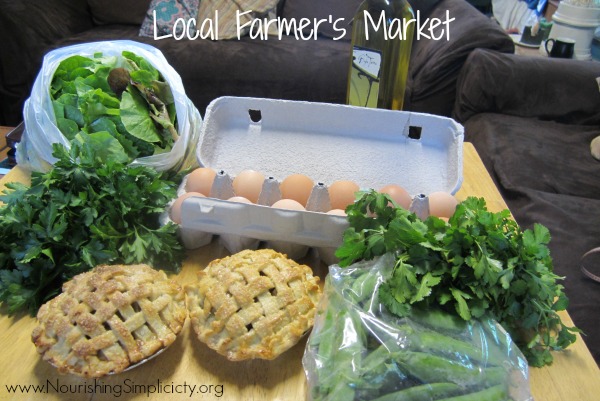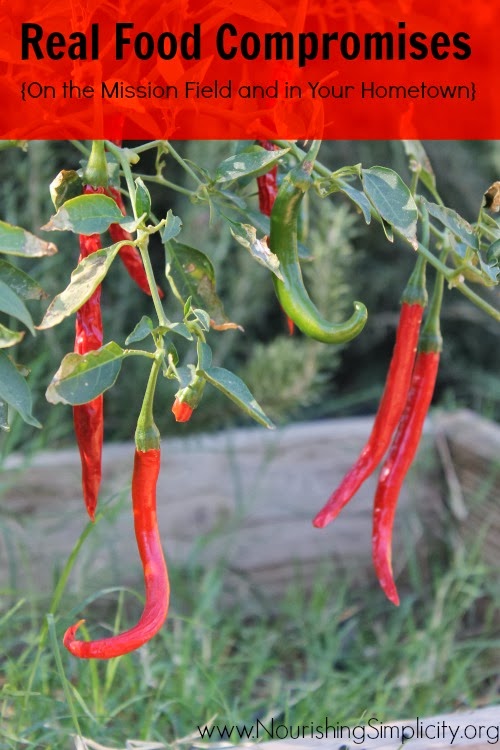Today is a guest post from Katie at Nourishing Simplicity, she and I go way back! We worked together for 2 years at Rancho Sordo Mudo, a free deaf school in Baja California. What Katie has to share with you today hits close to home with me as I live this out myself. I hope you will be encouraged and reminded that doing your best with what you have is better than nothing!
My real food journey was a slow one. I grew up eating mostly homemade meals with lots of whole grain, fruits and vrgtables. It wasn’t until my early twenties that I discovered The Makers Diet and Nourishing Traditions. Once I realized why a traditional real foods diet was so important I jumped on the band wagon full force. Within a year I was soaking grains and nuts, making sourdough, kefir and kombucha and desperately searching out a place to buy raw milk.
These days, it seems like every blog you read tells you all these list of rules of “do this & not that”. Such as, if you eat a bit of unsoaked grain you might as well kiss your digestive system goodbye or if your kid eats one more Red Food Dye 40 lollipop from the pinata. THEY. WILL. DIE!!!
The truth is, sometimes as hard as you try, you can’t eat perfect all the time. Sometimes, even the 80/20 rule doesn’t work. I’d love if it did, but it is not a reality for me.
I’m a missionary dorm mama to a bunch of amazing girls at a school for the Deaf in Valle de Guadalupe, Mexico. I care for 7 to 16 girls ages 5 to 18 most of the year. I don’t have a real kitchen (my girls eat in the dinning hall) and organic foods aren’t readily available.
I’m learning the art of compromise.
If you can’t have organic, pastured everything… then do the best with what you have. Worrying over what you aren’t feeding your family will make you sick and wear out much faster than eating less than perfect foods. The cows where I get my raw milk, for example, are mostly grain fed since I live in a very dry climate. For me, the benefits of raw milk outweigh the fact that they don’t have as much vitamin K as grass-fed milk does.
The 7 “real food” compromises I make
1. Buy Local and in Season
If you can’t find organic then local is the way to go! Think about all the farmers in your community that you are supporting by choosing to do this. As a missionary I love to see our community prosper and build relationships with the people who produce my food. I have also learned the joys of eating in season. The foods I buy locally are:
- Whole Chickens (fed veggie scraps and grains)
- Olive Oil (sprayed crop)
- Raw Honey
- Season Vegetables (organic)
- Occasionally Wheat Berries (requires sifting)
- Raw Milk and Cream (grain fed)

2. Buy Non-Processed
There are some things that I can’t find at the local farms that I do buy in the stores. I do my best to avoid anything in a package with an ingredient list. Some of my basic pantry staples come from the local mercados.
- Sugar (minimally processed)
- Piloncillo (similar to sucanat in a hard form)
- Corn Tortillas (treated with lime)
- Avocados, Mangos and Coconut (not local or organic)
- White Vinegar
- Butter
3. Grow/Raise Your Own
My girls and I continue to strive to grow a garden. Sometime the heat and lack of water (or too much water) do the little seedlings in, but there are a few things that we consistently grow each year. We also have a few chickens & a rooster and we may be getting a couple goats & a pig this year!
- Herbs (Cilantro, Peppermint, Spearmint, Chocolate Mint, Plantain, Lemon Balm, Rosemary, Basil, Lemon Grass, Lavender and Oregano)
- Carrots
- Tomatoes
- Garlic
- Green Onions
- Radishes
- Squash
- Eggs
- Roosters/Chicken (for meat)
- Citrus Trees (oranges, lemons, key limes, grapefruit and mandarins)
4. Scavenge/Forage
Life can be very busy no matter where you live. When I can find the time I forage in the hills where I live or pick unwanted fruit from friend’s trees.
- Olive Leaves
- White Sage
- Nopales (Cactus Paddles)
- Yuca Blossoms
- Pomegranates
- Figs
- Quince

5. Buy Online
When push comes to shove ordering online can be a life saver! I don’t have them shipped down here or I might never see them again. When home on furlough or when work teams are visiting this is a great time to stock up on essentials that you can’t find in your area. Ordering online is also a great way to save money on items when you are on a tight budget! Here is what I order online a few times a year (almost all of these are organic):
- Dried Bulk Herbs
- Wheat Berries
- Rice
- Legumes
- Coconut Oil
- Coconut Flour
- Almonds
- Canned Coconut Milk
- Apple Cider Vinegar
- Baking Powder and Soda
6. Make a Long Trip
Sometimes making a long trip to the nearest large city or, in my case, the next country over is another way I stock up on hard-to-find items. I do have the benefit of living a few hours from the Mexico/US border… so, I do make trips up occasionally for shopping in grocery stores there. When it comes to trips like this you have to factor in if the cost of gas and time to get there is worth the trip. When I do go, I shop at places like Costco, Trader Joe’s and Sprouts.
- Whole Chickens
- Ground Beef
- Sausage
- Butter
- Special Vegetables
7. Do Without
There are things that you would like to have, but just can’t be found where you live and is not possible to get through other methods. There are plenty of foods I wish I had but don’t and I need to be okay with that. Since I eat seasonally there are months where my favorite vegetables or fruits aren’t availible. Other times the cost to get it just isn’t possible or worth it or I run out before my next trip to the States.
Sometimes you have to learn how to do without. It’s not always fun, but it is reality. What are your tips on compromising?

Katie Mae Stanley is a missionary dorm “mama” to 10 amazing in girls ages 10 to 18 at a home and school for the Deaf in Baja California, Mexico. She is happiest in the kitchen creating nourishing meals and home remedies or outside with at least one of her girls at her side. Katie is passionate about real food, herbs and simple living. You can find her writing about all these things and more at Nourishing Simplicity.
